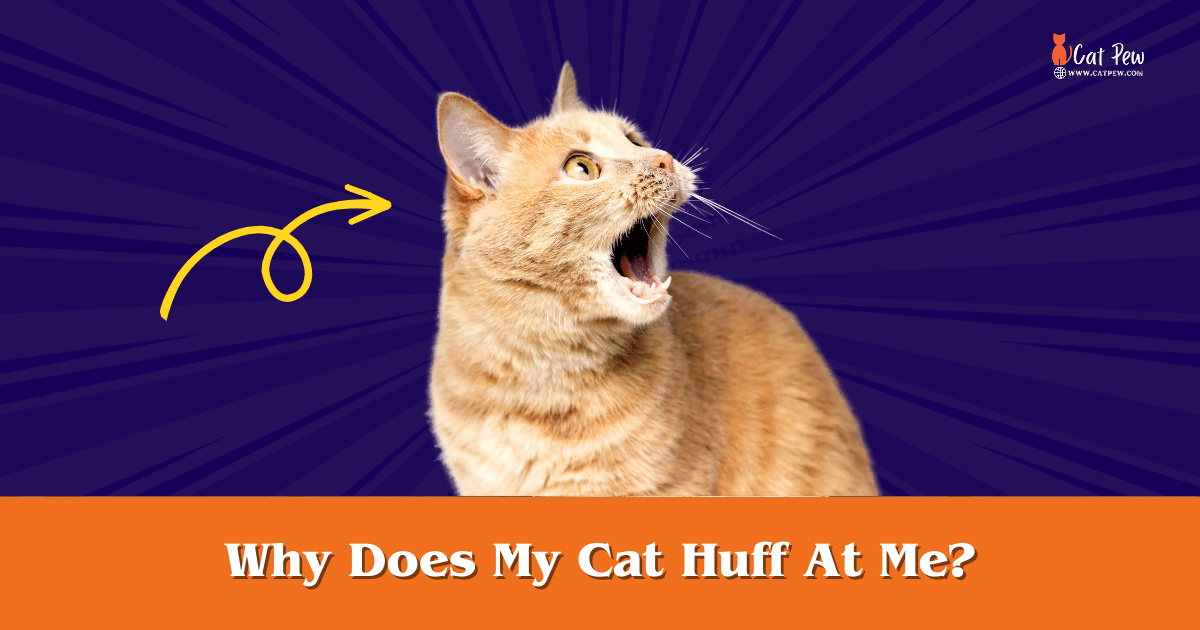Cat huffing at you is a common behavior and can indicate various emotions or intentions.
Understanding The Behavior And Communication Of Cats
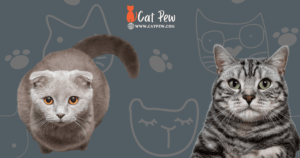
Understanding the behavior and communication of cats can help decipher why they huff at us. Their huffing is a form of communication, typically indicating frustration or unease. By observing their body language and considering their environment, we can gain insights into their emotions and respond appropriately.
Understanding the Behavior and Communication of Cats Cats are known for their mysterious and often bewildering behaviors. One fascinating behavior that can leave cat owners perplexed is cat huffing. Cat huffing occurs when a cat forcefully exhales through its mouth, creating a low grunting sound. While it may seem like an odd behavior, huffing is an essential part of a cat’s communication and can convey a range of meanings. In this section, we will delve deeper into the behavior of cat huffing and explore the factors that influence it. By understanding cat huffing, we can decode the messages our feline friends are trying to convey. The Meaning Behind Cat Huffing Huffing is a form of non-verbal communication used by cats to express various emotions and intentions. It serves as a way for them to communicate their feelings or establish boundaries. Some common meanings behind cat huffing include:
1. Warning or Aggression: When a cat huffs, it may be a sign of warning or aggression. This behavior often occurs when cats feel threatened or irritated. They use huffing as a way to assert their dominance and let others know to keep their distance.
2. Fear or Anxiety: Cats may also huff when they feel afraid or anxious. It can be their way of expressing discomfort or unease in a particular situation. Paying attention to other body language cues can help determine whether the huffing is a result of fear or anxiety.
3. Playfulness: Believe it or not, huffing can sometimes be a playful behavior. Younger cats, in particular, may huff during playtime to communicate their excitement or as a way to initiate play with their human or feline companions. Factors that Influence Cat Huffing Several factors can influence a cat’s tendency to huff.
Understanding these factors can provide insight into why a cat may engage in this behavior. Some key factors include:
1. Personality: Just like humans, cats have unique personalities. Some cats may naturally have a more vocal and expressive nature, leading them to huff more frequently compared to others.
2. Socialization: A cat’s early experiences and socialization can shape their behavior and communication style. Cats that have had limited socialization or have had negative experiences may be more prone to huffing as a defensive or fearful response.
3. Environment: The environment in which a cat lives can also play a role in their huffing behavior. Stressful or unfamiliar environments may trigger huffing as a way for cats to cope with their surroundings. Interpreting Cat Huffing Deciphering the meaning behind a cat’s huffing requires taking into account their overall body language and the context of the situation.
Here are a few tips to help interpret cat huffing:
1. Look for other signals: Pay attention to accompanying behaviors such as flattened ears, raised fur, or defensive postures. These additional cues can provide valuable insights into a cat’s emotional state.
2. Gauge the intensity: The intensity of the huffing can also give you clues about the cat’s intention. A soft, playful huff is likely a sign of excitement, while loud and forceful huffing may indicate aggression or fear.
3. Consider the situation: Understanding the context in which the huffing occurs is crucial. Is the cat interacting with another animal or human?
Did something in the environment provoke the huffing? Evaluating the situation can help in interpreting the huffing more accurately. In conclusion, cat huffing is a form of communication that holds significant meaning in a cat’s world. By understanding the behavior, factors, and interpretation of huffing, we can deepen our bond with our feline companions and ensure a more harmonious relationship. Remember to observe and interpret huffing alongside other behavioral cues to gain a better understanding of your cat’s emotions and intentions.
Recognizing Cat Huffing As A Form Of Communication
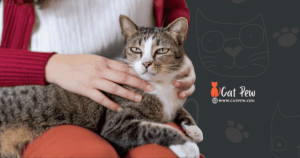
Cats are mysterious creatures, often relying on a variety of signals to express their thoughts and feelings. One such form of communication that cat owners may encounter is cat huffing. While it may seem peculiar or confusing at first, understanding the meaning behind this behavior can provide valuable insights into your feline companion’s emotions and needs. In this article, we’ll explore the various aspects of cat huffing, including the body language and facial expressions displayed by cats, the vocalizations they make, and the environmental context in which huffing occurs.
Body Language And Facial Expressions Of Cats
When it comes to deciphering cat huffing, paying attention to their body language and facial expressions is crucial. Cats are known for their ability to communicate through non-verbal cues, and these cues can be especially telling when it comes to huffing. Some key indicators include:
- Tail posture: An upright or slightly curved tail can indicate a confident and relaxed cat, whereas a puffed-up or tucked tail may signify fear or agitation.
- Ear position: Forward-facing ears generally indicate an alert and curious cat, while flattened ears can suggest aggression or discomfort.
- Eye contact: Direct eye contact, accompanied by dilated pupils, may signal an intense emotional state.
- Facial expressions: A relaxed face with a slight half-closed blink can indicate contentment, while a tense face with wide-open eyes and a tense mouth may indicate stress or fear.
Cat Vocalizations And Their Meanings
Another aspect of cat huffing involves understanding the vocalizations they make. Cats have a wide range of sounds they use to express themselves, and huffing is just one of them. Here are some common vocalizations and their meanings:
| Vocalization | Meaning |
|---|---|
| Growling | Sign of aggression or territoriality. |
| Purring | Generally associated with contentment and relaxation, but can also be a sign of pain or distress. |
| Meowing | Varies depending on the tone and duration. It can indicate a request for attention, hunger, or even a greeting. |
| Hissing | A warning sign of fear or aggression. |
Analyzing The Environmental Context
To fully understand cat huffing, it’s important to analyze the environmental context in which it occurs. Cats react to their surroundings, and huffing can be a response to various stimuli. Factors to consider include:
- The presence of other animals or humans
- Changes in the household routine
- Introduction of unfamiliar objects or scents
- Exposure to loud or disturbing noises
By observing and analyzing these contextual cues, you can gain valuable insights into why your cat may be huffing and take appropriate action to address their needs.
The Dynamics Of The Cat-owner Relationship

Building a strong and harmonious relationship with your cat is a delightful and rewarding experience. Cats are known for their curious and independent nature, which often adds an air of mystery to their behavior. However, understanding the dynamics of the cat-owner relationship is key to nurturing a bond based on trust and mutual affection. In this article, we will explore some of the common ways that cats express themselves and how owners can respond and foster a positive connection.
Establishing Trust And Bonding
When it comes to cats, trust is not something that can be rushed or forced. It is earned gradually through patience, consistency, and respect. Establishing trust is the foundation of a strong bond with your feline companion. Cats appreciate a calm and quiet environment where they can feel safe and secure. By providing them with their own space, a comfortable bed, and a variety of hiding spots, you can help to create an environment that encourages trust and relaxation. Additionally, engaging in gentle and positive interactions, such as petting and offering treats, can help to establish a sense of security and build a bond over time. Building trust is a gradual process, so be sure to give your cat the time and space they need to feel comfortable.
Seeking Attention Or Playtime
Like humans, cats seek attention and social interaction. They may exhibit various behaviors to communicate their desire for interaction or playtime. Some cats may meow softly or purr while rubbing against your legs, while others may bring you their favorite toys as an invitation to engage. It is important to recognize and respond to these signals, as neglecting their need for attention can lead to frustration or even behavioral issues. By taking the time to play with your cat using interactive toys or engaging in gentle play sessions, you not only provide them with mental and physical stimulation but also strengthen your bond. Remember, the more interactive and stimulating the playtime, the happier your cat will likely be.
Expressing Discomfort Or Fear
Cats are experts at expressing their feelings, including discomfort or fear. Cat owners must understand these signs and respond accordingly to help their feline friends feel safe and secure. Common signs of discomfort or fear in cats include hissing, growling, hiding, flattened ears, or an arched back. If you notice these behaviors, it is important not to force your cat into a situation that may be causing them distress. Instead, provide them with a quiet and secure space where they can retreat and feel protected. Creating a positive association with the feared stimulus through gentle exposure and positive reinforcement can help your cat overcome their fears gradually. By acknowledging and respecting their emotions, you can strengthen the trust between you and your cat while helping them feel more at ease in their environment. In conclusion, understanding the dynamics of the cat-owner relationship is crucial for building a strong bond based on trust, affection, and mutual understanding. By establishing trust and bonding gradually, responding to their attention-seeking behaviors, and addressing their discomfort or fear with empathy and patience, you can create a harmonious and fulfilling relationship with your beloved feline companion.
Strategies For Dealing With Cat Huffing Behavior
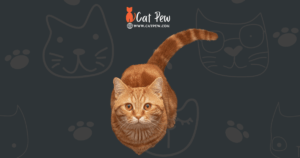
Cat huffing behavior can be concerning for cat owners, but there are several effective strategies you can employ to address this issue. By understanding the underlying reasons behind your cat’s huffing and implementing these strategies, you can help create a happier and more comfortable environment for your feline friend. In this article, we will explore three key approaches to managing cat huffing behavior: building positive associations through rewards, creating a safe and comfortable environment, and seeking professional guidance for severe cases.
Building Positive Associations Through Rewards
One effective way to address cat-huffing behavior is to build positive associations with certain people, objects, or situations. By rewarding your cat with treats, praise, or play whenever they exhibit calm and relaxed behavior, you can help them associate those positive behaviors with positive outcomes. This positive reinforcement technique can gradually replace huffing as a response to stress or fear.
- Reward your cat with their favorite treats or toys when they approach unfamiliar people or animals calmly.
- Provide positive reinforcement immediately after your cat displays relaxed body language or exhibits non-huffing behavior.
- Be consistent and patient. It may take time for your cat to associate positive experiences with previously triggering situations.
Creating A Safe And Comfortable Environment
A cat’s environment plays a crucial role in their overall well-being. To help manage huffing behavior, it’s important to create a safe and comfortable space for your feline companion. This can significantly reduce their stress and anxiety levels, leading to less frequent huffing episodes. Consider the following tips when creating a cat-friendly environment:
- Ensure your cat has a quiet and private area to retreat to when they feel overwhelmed.
- Provide ample scratching posts and toys to encourage appropriate outlets for their energy and natural behaviors.
- Offer a variety of hiding spots or elevated perches where your cat can feel secure and observe their surroundings.
- Maintain a consistent routine for feeding, playtime, and interaction to instill a sense of security and predictability.
Seeking Professional Guidance For Severe Cases
If your cat’s huffing behavior persists despite your best efforts, it may be necessary to seek professional guidance. Consulting with a veterinarian or a qualified animal behaviorist can help identify any underlying health issues or provide additional strategies specific to your cat’s needs. In severe cases, the professional may suggest techniques such as:
| Technique | Description |
|---|---|
| Desensitization | Gradually expose your cat to the triggers of their huffing behavior while providing positive reinforcement, helping them overcome their fear. |
| Counter-conditioning | Pairing the triggers of huffing with highly rewarding experiences to replace the negative associations with positive ones. |
| Medication | In some cases, medication may be prescribed to address underlying anxiety or medical conditions contributing to huffing behavior. |
Remember, each cat is unique, and what works for one may not work for another. By implementing these strategies and seeking professional guidance when needed, you can improve your cat’s well-being and reduce their huffing behavior over time.
Techniques To Improve Communication And Connection
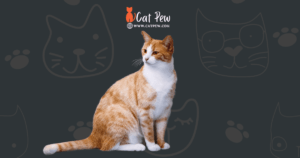
Improving communication and connection with your cat is crucial for building a strong bond and creating a harmonious relationship. By employing effective techniques, you can enhance interactive play sessions, implement positive reinforcement training, and nurture emotional support for your furry friend. In this blog post, we will explore each of these techniques in detail.
Enhancing Interactive Play Sessions
Interactive play sessions with your cat not only serve as great exercise but also provide an opportunity to strengthen your bond. Here are a few techniques to maximize the effectiveness of these sessions:
- Use a variety of cat toys: Choose toys that reflect your cat’s preferences and engage their instincts. This can include interactive wand toys, puzzle toys, or balls that encourage chasing and pouncing.
- Rotate and introduce new toys: Cats can quickly lose interest in the same toys. To keep them engaged, regularly rotate the toys on offer. Introduce new toys periodically to stimulate their curiosity.
- Emphasize quality over quantity: Instead of lengthy play sessions, focus on shorter, high-energy bursts of play. This mimics the hunting behavior of cats and keeps them mentally and physically active.
- Follow your cat’s lead: Pay attention to your cat’s body language during play. If they seem overwhelmed or disinterested, tone down the intensity or switch to a different activity.
Implementing Positive Reinforcement Training
Positive reinforcement training is an effective way to communicate with your cat and reinforce desired behaviors. Follow these steps to implement this training technique:
| Steps for Positive Reinforcement Training | Explanation |
|---|---|
| Identify desired behavior | Define the behavior you want to encourage, such as using a scratching post instead of furniture. |
| Choose a reward | Select a treat, toy, or verbal praise that your cat finds rewarding. |
| Associate reward with behavior | Immediately give the reward when your cat performs the desired behavior. |
| Consistency is key | Reinforce the behavior consistently for it to become habitual for your cat. |
Nurturing Emotional Support For Cats
Cats are emotional beings and require a nurturing environment to thrive. Here are some strategies to provide emotional support for your feline companion:
- Create a safe and comfortable space: Designate a quiet area where your cat can retreat and feel secure. Provide cozy bedding, hiding spots, and a scratching post.
- Maintain a consistent routine: Cats appreciate predictability and thrive on routine. Stick to regular feeding times, play sessions, and grooming rituals.
- Offer gentle affection: Show your love and affection for your cat through gentle petting, verbal reassurance, and engaging in activities they enjoy.
- Respect their boundaries: Just like humans, cats have boundaries. Pay attention to their body language and avoid forcing interactions when they’re not in the mood.
By implementing these techniques to improve communication and connection with your cat, you can foster a deep and fulfilling relationship that will bring you both joy and happiness. https://youtu.be/WewN11o7Afs
Frequently Asked Questions For Cat Huff At Me
What Does It Mean When Cats Huff At You?
Cats huffing at you may mean they’re annoyed or afraid. It’s their way of showing discomfort or aggression towards something. Try understanding their body language to avoid aggravating them further.
Why Does My Cat Huff And Bite Me?
Cats may huff and bite to express discomfort, fear, or frustration. It’s important to understand their body language and address their needs to prevent such behavior. Provide them with a safe and calm environment, regular play and interaction, and consult with a veterinarian if the biting persists.
What Does It Mean When My Cat Exhales Loudly?
Excessive loud exhaling in cats may indicate a variety of issues such as respiratory problems or upper respiratory infections. It’s important to monitor their breathing and consult a veterinarian for a proper diagnosis and treatment.
Is Cat Huffing Safe?
Cat huffing is not safe for cats. It can cause respiratory problems, irritation, and discomfort for the cat.
Conclusion
Interacting with a cat that huffs at you can be a puzzling experience. While it may be tempting to take it personally, understanding their behavior is key. By creating a calm and comforting environment, providing mental and physical stimulation, and seeking professional advice if needed, you can build a harmonious relationship with your huffy feline friend.
Remember, patience and love go a long way in establishing trust and improving their well-being. Happy huffing!

Winston
I'm Winston, the author of this feline-focused (Catpew.com) blog . My love for cats goes back to my childhood, when I spent countless hours playing with my family's tabby, Mittens. This furry friend instilled in me a deep appreciation for the unique personalities, playful nature, and unconditional love that cats offer.

